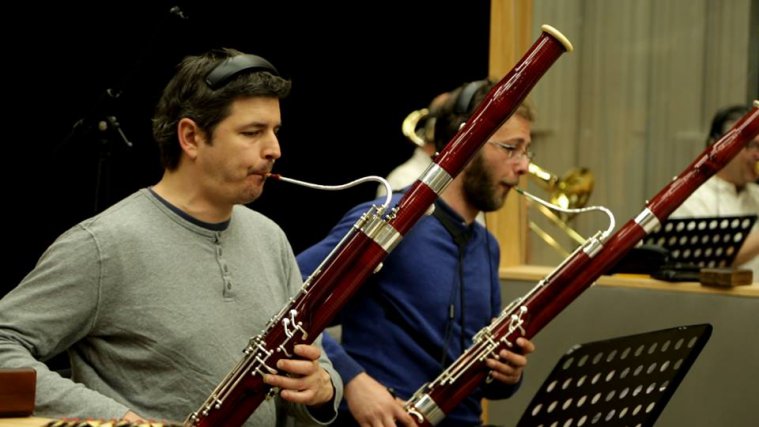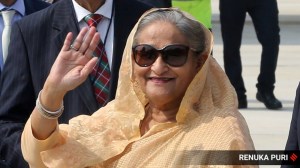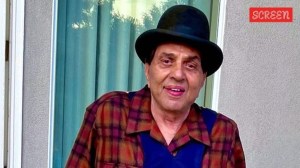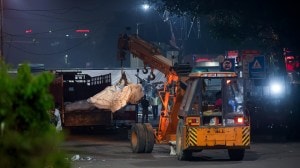Project Borgeet: Syncing Assam’s 600-year-old songs to the symphonic orchestra
A young musician has led Assam's 600-year-old Borgeet to be recorded by the Macedonian Symphonic Orchestra, in an initiative that is first of its kind and scale.
 Musician Anurag Saikia with the members of FAME’S – Macedonian Symphonic Orchestra for Project Borgeet. (Photo Courtesy: FAME’S – Macedonian Symphonic Orchestra | Facebook)
Musician Anurag Saikia with the members of FAME’S – Macedonian Symphonic Orchestra for Project Borgeet. (Photo Courtesy: FAME’S – Macedonian Symphonic Orchestra | Facebook)
In the early 1990s, Anurag Saikia grew up in a house full of gramophone records — 15,000 to be precise. Every morning, his father would play one of them: maybe Bach, maybe Mozart. And in another part of their house in Upper Assam’s Moran town, his mother would start singing a Borgeet on the same scale.
The apple hasn’t fallen far from the tree. Today, 30-year-old Saikia — a National Award-winning musician — is a couple of months away from launching his dream project. In it, 600-hundred-year old Borgeet, a genre of Assamese devotional songs created by 15th-century poet-saint Srimanta Sankardeva and his disciple Madhabdeva, will be recorded by the Macedonian Symphonic Orchestra, one of the first ever initiatives of its kind and scale.
In 2012, US-based Jayanta Pathak had released an album of six Borgeet tracks, Dokho Avatar, based on a similar concept but on a smaller scale. While Pathak’s album was instrumental, Saikia is going the whole hog: not just instruments, but lyrics and vocals, accompanied by an orchestra of more than 80 musicians. The Assamese musician is well aware of what is at stake.
For long, the Borgeet genre, predominantly described as devotional, has been defined by the ways and rules set by three Sattras (or monastic orders started by Sankardeva) in Barpeta, Bordua and Kamalabari in Assam.
 The project will involve a symphonic recording of the 600-year-old Assamese devotional songs composed by 16th-century poet-saint Srimanta Sankardeva. (Photo Courtesy: FAME’S – Macedonian Symphonic Orchestra | Facebook)
The project will involve a symphonic recording of the 600-year-old Assamese devotional songs composed by 16th-century poet-saint Srimanta Sankardeva. (Photo Courtesy: FAME’S – Macedonian Symphonic Orchestra | Facebook)
“But the essence of the world today is collaboration,” says Saikia, a key learning from the time he was a student of the Swanabhoomi Academy of Music in Chennai.
Borgeet, according to studies and research, has distinct elements of classical music even though it is yet to be recognised as a classical art form by the Sangeet Natak Akademi.
“So my aim was to bring together two strains that already complement each other,” explains Saikia, “It’s not fusion, you can call it a collaboration. Never did I say that I wanted someone jumping up and down with a guitar, singing a Borgeet.”
‘IT CAN FIX A BROKEN HEART’
In April, Saikia travelled to Macedonia to get two Borgeet, Are Kompito and Faagu Khele, recorded by the world-renowned FAME’s Macedonian Symphonic Orchestra. “The vocals by Assamese singers will be set to music by the orchestra,” says Saikia, who will be uploading the finished project on his Youtube channel in December.
While the project only took off last year, Saikia says that this had been his dream ever since he was a little boy. “Nowadays when Borgeet are performed, a very few instruments are used: There will be the khool (a percussion instrument), a baahi (flute) and a kind of violin. When I used to see these [performances] as a kid, I would wonder, what if this was performed to a thousand violins?”
While Saikia works independently as a music director in Bollywood movies (his repertoire includes films like Mulk and Article 15) in Mumbai as well as Assamese features (such as Santana Bordoloi’s Maaj Raati Keteki and Utpal Borpujari’s Ishu) when he is in Assam, he would periodically reach out to orchestra groups in different parts of the world — Vienna, Prague, and London — with his idea.
 More than 85 musicians took part in the recording. (Photo Courtesy: FAME’S – Macedonian Symphonic Orchestra | Facebook)
More than 85 musicians took part in the recording. (Photo Courtesy: FAME’S – Macedonian Symphonic Orchestra | Facebook)
The budgets were “scary” and the project was put off many times before an old family friend (and a good samaritan) Shyamantak Gautam came to the rescue and offered to fund the entire project.
“Shyamantak da understood the importance of the project — why I was really doing it,” says Saikia, “The fact is not many people, especially outside Assam, know about Borgeet.”
For long, sung only in Sattras, Borgeet are tied down by strict rules of how and when they can be sung. “Most of the time they are sung only on occasions, during functions and such. But I want to show that they can be sung — and heard — any time of the day, every day. There is nothing a Borgeet can’t fix, even if it’s a broken heart.”
While there has been an increasing chorus of voices that have pushed for the Borgeet to get classical recognition, Dr Sudarshana Baruah, an Indian Classical composer who has closely studied Assamese traditional music, says that similarities to classical music apart, a basic grammar needs to be developed for the genre before it earns the status. “The truth is the Borgeet we know today is very different from what Saint Sankardeva had composed 600 years ago,” she says.
PROJECT BORGEET
At Macedonia, when Saikia was there for the recording, one of the conductors had asked him, “These songs are mesmerising and more than a hundreds of years old. How do you know what you have brought us is the correct, purest one?”
 The songs will be uploaded online on Anurag Saikia’s YouTube music channel. (Photo Courtesy: FAME’S – Macedonian Symphonic Orchestra | Facebook)
The songs will be uploaded online on Anurag Saikia’s YouTube music channel. (Photo Courtesy: FAME’S – Macedonian Symphonic Orchestra | Facebook)
For Saikia, who grew up among music and musicians, this was some food for thought. “On my return to India, I consulted many who have studied Borgeet for years — Pabitrapan Goswami of Jorhat, Krishna Goswami of Guwahati and Ranjit Mahanta of Nagaon as well as Sattradhikars Basistha Dev Sarma, Parmananda Deva Mahanta and Devananda Deva Goswami — to learn that the three Sattras (Kamalabari, Barpeta and Bordua) each had its own unique style of rendering the same Borgeet,” he says. Each was different from the other, but all three are equally correct.
“The saints Sankardeva and Madhavdeva never wrote any notations, so over the years, passed down from generation to generation, the Borgeet has changed. But the main style is based on these three Sattras,” says Saikia. To that end, he is also making a documentary on the genre which will have “answers from experts on questions like these.”
In Macedonia, when Saikia heard the first performance of the Borgeet, as the orchestra of sounds of 85 musicians playing cellos, violins, French horns, clarinets etc filled the room, it was a very emotional moment.
“I realised then itself that for me, the project was a success. Suppose fifty years later, someone asks any of these musicians — who hail from London, Moscow etc — if they know what a Borgeet is, they won’t just know of it, they would have played it,” he says.





- 01
- 02
- 03
- 04
- 05


























